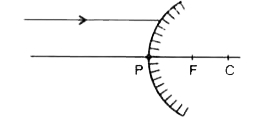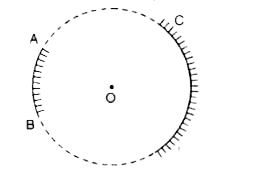Complete Solutions to TOPIC-1 REFLECTION OF LIGHT, IMAGE FORMED BY SPHERICAL MIRRORS (SHORT ANSWER TYPE QUESTIONS I) of chapter LIGHT-REFLECTION AND REFRACTION of Class 10 book with complete answers and questions
| Class 10 | PHYSICS |
| Chapter | LIGHT-REFLECTION AND REFRACTION |
| OSWAAL PUBLICATION | TOPIC-1 REFLECTION OF LIGHT, IMAGE FORMED BY SPHERICAL MIRRORS (SHORT ANSWER TYPE QUESTIONS I) |
| Number Of Questions | 20 |
| Academic Year | 2023-24 |
List four characteristics of the image formed by plane mirrors.
View SolutionList two properties of the images formed by convex mirrors. Draw ray diagram in support of your answer.
03:18View SolutionList four specific characteristic of the images of the objects formed by convex mirrors.
03:17View SolutionDifferentiate is real image from a virtual image giving two points of difference.
02:11View SolutionYou are given a concave mirror, plane mirror anda convex mirror. How can you distinguish between them by just looking your face in them. State the common nature of the image that you see in all of them.
02:36View SolutionA ray of light travelling in air enters obliquely into water. Does the light ray bend towards the normal or away from the normal? Why?
View SolutionState two positions in which a concave mirror produces a magnified of a given object. List two differences between the two images.
OR
List two possible ways in which a concave mirror can produce a magnified image of an object placed in front of it. State the difference if any between these two images.02:39View SolutionA ray of light is incident on a convex mirror as shown. Redraw the diagram and complete the path of this ray after reflection from the mirror. Mark angle of incidence and angle of reflection on it.
 02:51View Solution
02:51View SolutionThe linear magnification produced by a spherical mirror is +3. Analyse this vale and state the (i) type of mirror and (ii) Position of the object with respect to the pole of the mirror. Draw ray diagram to show the formation of image in this case.
03:54View SolutionAB and CD two spherical mirrors, forms parts of a hollow sherical ball with its centre at O as shown in the diagram. If arc `AB=1/2` arc CD, what is the ratio of their focal lengths? State which of the two mirrors will always from virtual image of an object placed in front of it and why?
 View Solution
View SolutionName the type of mirrors used in the design of solar furnaces. Explain how hgih temperature is achieved by this device.
View SolutionThe magnification produced by a spherical mirror is -3". List four informations you obtain from this statement about the mirror/image.
View SolutionDraw a ray diagram to show the path of the reflected ray corresponding to an incident ray of light parallel to the principal axis of a convex mirror and show the angle of incidence and angle of relection on it.
View SolutionThe imasge formed by a concave mirror is observed to be virtual, erect and larger than the object where should be the position of the object relative to the mirror? Draw ray diagram to justify your answer.
View SolutionDraw a ray diagram to show the path of the reflected ray corresponding to an incident ray which is directed parallel to the principal axis of a concave mirror. Mark on it the angle of incidence and the angle of reflection.
View SolutionA concave mirror of focal length f can form a magnified erect as well as an inverted image of an object placed in front of it. Justify this statement starting the position of the object with respect to the mirror in each case for obtaining these images.
View SolutionAn object is placed at a distance of 20 cm from a convex mirror of focal length 15 cm. Find the position and nature of the image.
View SolutionThe radius of curvature of a concave mirror is 50 cm. Where should an object be placed from the mirror so as to form its image at ifinity? Justify your answer.
View SolutionAn object is placed at a distance of 20 cm in front of convex mirror of radius of curvature 30 cm. Find the position and nature of the image.
View SolutionAn object is kept at a distance of 5 cm in front of a convex mirror of focal length 10 cm. Calculate the position and nature of the image formed.
View Solution
TOPIC-1 REFLECTION OF LIGHT, IMAGE FORMED BY SPHERICAL MIRRORS (SHORT ANSWER TYPE QUESTIONS I) questions and complete solutions for chapter LIGHT-REFLECTION AND REFRACTION of OSWAAL PHYSICS (KANNADA ENGLISH) of Class 10
All Exercises from OSWAAL PUBLICATION Class 10 PHYSICS LIGHT-REFLECTION AND REFRACTION
- NCERT CORNER (TEXTBOOK EXERCISES)
- NCERT CORNER (INTEXT QUESTIONS)
- NCERT CORNER(INTEXT QUESTIONS)
- TOPIC -2 REFRACTION, LENSES, POWER OF LENS (LONG ANSWER TYPE QUESTIONS II)
- TOPIC -2 REFRACTION, LENSES, POWER OF LENS (MULTIPLE CHOICE QUESTIONS)
- TOPIC -2 REFRACTION, LENSES, POWER OF LENS (SHORT ANSWER TYPE QUESTIONS I)
- TOPIC -2 REFRACTION, LENSES, POWER OF LENS (SHORT ANSWER TYPE QUESTIONS II)
- TOPIC -2 REFRACTION, LENSES, POWER OF LENS (VERY SHORT ANSWER TYPE QUESTIONS)
- TOPIC-1 REFLECTION OF LIGHT, IMAGE FORMED BY SPHERICAL MIRRORS (LONG ANSWER TYPE QUESTIONS II)
- TOPIC-1 REFLECTION OF LIGHT, IMAGE FORMED BY SPHERICAL MIRRORS (MATCH THE COLUMN)
- TOPIC-1 REFLECTION OF LIGHT, IMAGE FORMED BY SPHERICAL MIRRORS (MULTIPLE CHOICE QUESTIONS)
- TOPIC-1 REFLECTION OF LIGHT, IMAGE FORMED BY SPHERICAL MIRRORS (SHORT ANSWER TYPE QUESTIONS I)
- TOPIC-1 REFLECTION OF LIGHT, IMAGE FORMED BY SPHERICAL MIRRORS (SHORT ANSWER TYPE QUESTIONS II)
- TOPIC-1 REFLECTION OF LIGHT, IMAGE FORMED BY SPHERICAL MIRRORS (VERY SHORT ANSWER TYPE QUESTIONS)
